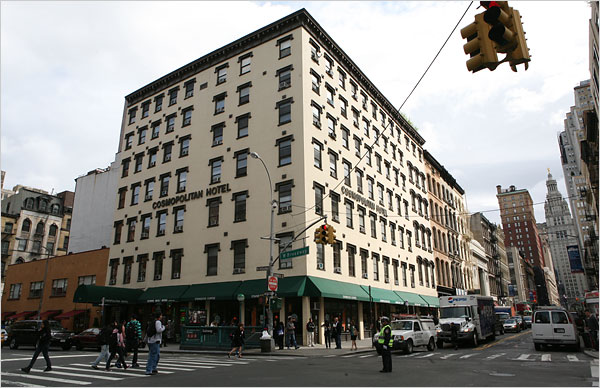The Granddaddy of Them All
By CHRISTOPHER GRAY - 10/8/2009IT’S a classic railroad hotel, although the railroad left more than a century ago. These days, the 1845 Cosmopolitan Hotel, at Chambers Street and West Broadway, caters to a subway crowd, its Web site listing rooms for $149 for budget-minded tourists.
The Cosmopolitan Hotel
Possibly New York’s oldest hotel structure, it has been loved to death, with successive alterations using the original neo-Gothic style, each one meant to match the original building. Now another change is in the offing, with a different tack.
Chambers and nearby streets attracted houses for the gentry around the time City Hall was completed two blocks away in 1812. Six years later, Isaac Jones Jr. and his wife, Mary, built a house at 122 Chambers Street, said to have been the first in New York to have a bathtub.
These families began departing within a few decades as commerce took over the area, and in 1844-45 James Boorman, a merchant of tobacco, Madeira, ironwork and other goods, built a boarding house at the northeast corner of Chambers and West Broadway. Boorman was also a founder of the new Hudson River Railroad, then about to build its southerly depot across the street, with tracks running up Hudson Street and along the Hudson River.
A print from 1851 at the Museum of the City of New York shows the boarding house to be a four-story red brick structure, its second floor ringed by a lacy, New Orleans-style iron balcony, the windows and cornice with neo-Gothic trim. The neo-Gothic flourished in this period, but survivors are now unusual.
The print bears the legend “Frederick Hotel,” although it appears that nobody but the printmaker knew it by that name. By 1854 it was definitely operating as a hotel, the Girard House.
In the late 1860s, the Girard was raised to six stories with a small attic in the same neo-Gothic style, even though it was long out of fashion, and renamed the Cosmopolitan. Almost simultaneously the railroad moved its depot farther uptown, and the Cosmopolitan lost its railroad trade.
But in 1894, the hotel was still important enough for the Massachusetts merchant Benjamin Low, described by The New York Times as “one of the richest men in Gloucester,” to take a room there. He was in New York to inspect a cargo of Newfoundland herring, but was found dying on the ground on West Street, perhaps of natural causes, his pockets empty.
No later than the turn of the century the red brick had been painted light yellow or beige.
The Cosmopolitan continued as a business hotel, and in 1897 a group of ticket brokers gathered there to protest a new anti-scalping law. It had been their practice to buy up railroad tickets and sell them to desperate travelers.
In July 1923, a Times reporter found a group of elderly traveling salesmen sitting outside complaining that the Fourth of July had been sanitized. One said that “it’s safe and sane all right, but it’s mighty tame” — not at all as celebrated in his youth, by firing muskets and shotguns in the air.
The 1930 census found a marine engineer, a boiler maker, a tea mixer and a radio operator living there; all occupations were typical of the lower West Side. Six years later an advertisement in The Times offered rooms at $4 per week, while the typical hotel charged $9 or $10.
Although a 1940 photograph shows a large sign, “Families Accommodated,” by the 1960s the Cosmopolitan, now known as the Bond, had evolved into an S.R.O., or single room occupancy residence. In 1967, The Times reported that a drifter who lived there had been arrested for murder after stabbing a customer in a store downstairs in a dispute over 2 cents.
The Bond name was dropped, apparently to distance the place from its unsavory reputation, and the hotel became the Cosmopolitan again. In 1989 a seventh floor was added, also in the Gothic style, and painted to match the rest of the building, the intent being to make it look as if it had always been there.
Now the Do-Bar Hotel Corporation, including the veteran investor Jay Wartski, has retained Franke, Gottsegen, Cox to design yet another addition, this one an annex along West Broadway at the Reade Street end of the lot. The site is within the TriBeCa South Historic District, and the architects have avoided replicating the Gothic format yet again — imitation is not the sincerest form of flattery in formal preservation practice.
Instead, the firm has prepared drawings for a handsome, retiring six-story brick building, quite different from the old structure, and promising to add a little bounce to its old neighbor by sheer contrast. The Landmarks Preservation Commission approved the addition last month.
Matthew Gottsegen, a partner, says that almost nothing original is left inside the old hotel, which alterations have turned into a labyrinth.
As for the exterior, architecture repeatedly altered in various modes often becomes richly layered in nuance, like an old brownstone with an Edwardian rooftop and an Art Deco storefront. But the Cosmopolitan was long ago swamped by good intentions.
